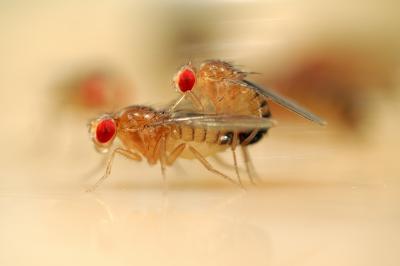Why do females sometimes ignore males and sometimes stop and pay attention?
There are many conjectures: looking like Ryan Gosling seems to help but there are a lot of other variables: if the female is under the age of 30, a male being unemployed while he 'gets his band together' is sometimes fine, yet after age 30 females regard that as unacceptable.
It's not legal to research on humans so psychologists are stuck with surveys of college students, but biologists can study flies. And it holds true there; if you are going to get a mate, you first have to get her to notice. Researchers can determine what is happening even if they can't determine why; in a Current Biology study, Dr. Leslie Vosshall of The Rockefeller University in New York City and her team found that a small group of neurons in the abdominal nerve cord and reproductive tract—called Abdominal-B neurons—is necessary for the female to pause her movement and interact with a courting male.

This image depicts copulating flies. Credit: Solvin Zankl
When the neurons are inactivated, the female ignores the male and keeps moving, but when the neurons are activated, the female spontaneously pauses.
"Sexual courtship is a duet—the male and female send signals back and forth until they reach the point that copulation proceeds," says Dr. Jennifer Bussell, the lead author of the study. "Pausing to interact with a male, rather than avoiding him, is a crucial step in any female's behavior leading to copulation. Tying a group of neurons to this particular response to males will allow us to dissect in detail how female mating circuitry functions."

This image illustrates the circuit controlling sexual receptivity, as we now understand it. The sketch shows a transparent fly with the female reproductive system and nervous system. In dark orange are the neurons that we now know to be central for controlling sexual receptivity -- as you can see they connect the uterus to the brain. Credit: Mark Palfreyman
In another Neuron paper, researchers studied the effects of a small protein called sex peptide that is transferred along with sperm from males to females and is detected by sensory neurons in the uterus. Sex peptide changes the female's behavior so that she is reluctant to mate again for about 10 days.
The investigators traced the neuronal pathway that is modulated when the uterus's sensory neurons detect sex peptide. "Thanks to our work, we think the sex peptide signal goes to a region of the fly's brain that is the homolog of the hypothalamus, which has been know for many years to be central in controlling sexual receptivity in vertebrates," explains co-lead author Dr. Mark Palfreyman of the Research Institute of Molecular Pathology in Vienna, Austria.
This region of the brain links the nervous system to the endocrine, or hormonal, system. "Of course, these models will still need to be tested and our work only provides an initial glimpse, but our study opens the possibility that analogous neuroendocrine systems control sexual receptivity from flies to vertebrates," adds senior author Dr. Barry Dickson, who was also a co-author on the Current Biology paper published by Dr. Vosshall.




Comments